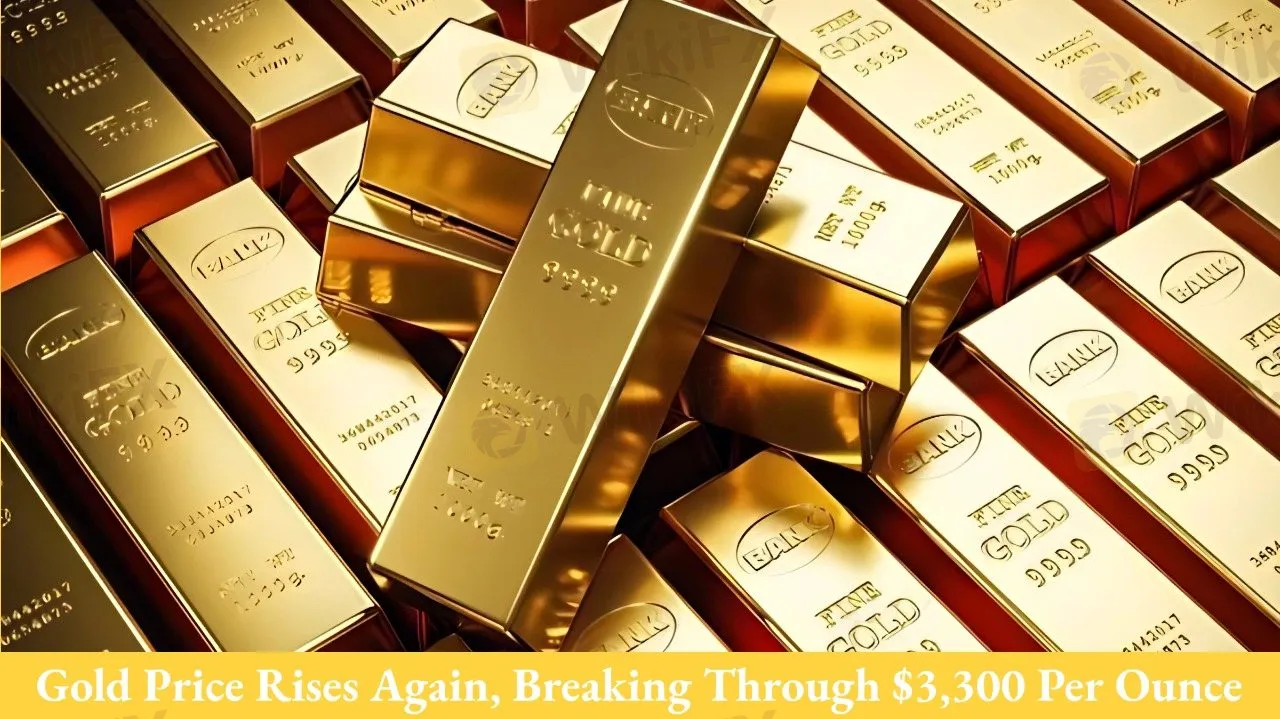简体中文
繁體中文
English
Pусский
日本語
ภาษาไทย
Tiếng Việt
Bahasa Indonesia
Español
हिन्दी
Filippiiniläinen
Français
Deutsch
Português
Türkçe
한국어
العربية
Gold Price Rises Again, Breaking Through $3,300 Per Ounce
Abstract:This article analyzes the reasons behind the rise in gold prices and explores the challenges the market may face in the future, as well as the potential risks and opportunities for investors.

In the Asian trading session on Monday, gold prices surged, with spot gold rising to $3,255.95 per ounce, and gold futures surpassing $3,300. Despite the rise in gold prices, the gains were somewhat limited due to the market's cautious optimism regarding potential US-China trade talks and investors' cautious stance ahead of the Federal Reserve's interest rate decision later this week. The moderate rebound in gold prices follows a 2% pullback last week, as global market sentiment improved and signs of easing trade tensions between the two largest economies emerged.
Gold's recent surge can largely be attributed to the weakening of the US dollar. The US Dollar Index dropped by 0.2% during the Asian trading session, making gold cheaper for foreign buyers. Since gold is typically priced in dollars, a weaker dollar often leads to an increase in gold prices, as it becomes more attractive to investors holding other currencies.
Factors Behind the Rise in Gold Prices
The recent surge in gold prices can be attributed to several factors, primarily linked to shifts in market sentiment and economic policies. Besides the weakness of the US dollar, there is also a prevailing sense of caution regarding the Federal Reserve's stance on monetary policy. Despite the wide-reaching impact of the Fed's decisions, markets expect the central bank to maintain a cautious approach, particularly as it evaluates the effects of global trade dynamics and tariff policies.
Low interest rates tend to support gold prices, as they enhance the appeal of non-yielding assets like gold. As long as rates remain low, investors will continue to flock to gold as a store of value. Moreover, the uncertainties surrounding the global economy, including the ongoing trade tensions between the US and China, have further bolstered golds status as a safe haven asset.
Market optimism over potential talks between the US and China has also played a role in limiting the upside of gold. China recently stated that it is considering the possibility of trade talks with the US, and any discussions must be based on sincerity and the removal of unilateral tariffs. This shift in the tone of the trade conflict has alleviated some of the concerns in the market, diminishing the immediate demand for safe-haven assets like gold.
Challenges Facing the Market in the Future
Despite the rise in gold prices, several challenges remain for the market. First, the uncertainty surrounding global trade tensions is far from resolved. While there is optimism that the US-China trade war may ease, any future escalation in trade frictions could lead to sharp fluctuations in market sentiment, which would impact the demand for gold. Investors must stay attuned to updates on the trade talks, as any developments could lead to significant shifts in the market.
Additionally, the future direction of US monetary policy remains a key factor influencing gold prices. While markets currently expect the Federal Reserve to keep rates unchanged, any shift toward rate hikes in the future could put downward pressure on gold. Interest rate hikes typically reduce the attractiveness of gold, as higher rates increase the returns on yield-bearing assets like bonds and savings accounts. Therefore, investors need to monitor the Federal Reserve's policy meetings and adjust their strategies accordingly.
Challenges and Opportunities for Investors
For investors, the recent rise in gold prices presents both opportunities and challenges. The ongoing surge in gold prices has prompted some investors to enter the market, seeking to capitalize on the metal's potential. However, purchasing gold at historically high prices can be risky, especially as gold prices approach record levels. Investors must be cautious about entering the market at such high prices, as there is a possibility of a market correction in the short term.
On the other hand, gold continues to hold long-term appeal as a safe-haven asset. Given the ongoing uncertainties in the global economy, the potential for geopolitical risks, and the unpredictable nature of monetary policies, gold remains an attractive investment. However, it is important for investors to remember that gold prices can be highly volatile. The key to navigating this market is diversification—investors should avoid putting all their funds into gold and should consider allocating investments across different assets to manage risk.
Moreover, the decline in global gold jewelry consumption presents a shift in the market dynamics. According to the World Gold Council, despite the continuous rise in gold prices, the demand for gold jewelry has dropped, with a 21% year-on-year decline. This suggests that while golds investment appeal is growing, its consumption demand is waning. Investors should factor in this trend when considering gold as an investment.
Furthermore, central banks‘ growing interest in gold adds another layer to the investment landscape. For instance, India’s central bank has increased its gold reserves, further signaling that gold is considered a crucial asset for national economic security. As more countries move to diversify their foreign exchange reserves with gold, the long-term outlook for gold remains positive, even though short-term fluctuations are inevitable.
Conclusion
Gold prices have broken the $3,300 per ounce barrier, once again attracting significant attention from investors and market participants. While the weakening US dollar and cautious Federal Reserve stance have supported golds rise, the ongoing trade uncertainties and the direction of future monetary policies will continue to influence gold prices. Investors must exercise caution in the face of high prices and market volatility, maintaining flexibility in their strategies. Although challenges remain, gold's status as a safe-haven asset and its growing role in central bank reserves indicate a promising long-term investment outlook. To navigate the complexities of the gold market, investors should focus on diversification and stay informed about global economic developments.

Disclaimer:
The views in this article only represent the author's personal views, and do not constitute investment advice on this platform. This platform does not guarantee the accuracy, completeness and timeliness of the information in the article, and will not be liable for any loss caused by the use of or reliance on the information in the article.
Read more

OctaFX Flagged by Malaysian Authorities
OctaFX has been officially listed on warning lists by both Bank Negara Malaysia (BNM) and the Securities Commission Malaysia (SC). These alerts raise serious concerns about the broker’s status and whether it is legally allowed to operate in Malaysia.

TradingPRO: A Closer Look at Its Licences
In an industry where safety and transparency are essential, the regulatory status of online brokers has never been more important. For traders seeking to protect their capital, ensuring that a platform operates under recognised and stringent oversight can make all the difference. Keep reading to learn more about TradingPRO and its licenses.

Oil Price Breakout Incoming? Investors Should Stay Alert
Oil prices are hovering around a critical level, with potential yet to be fully unleashed. Investors must prepare for sudden changes.

New SEBI Regulations on Intraday Trading
The Securities and Exchange Board of India (SEBI) has implemented revised regulations on Intraday trading, with effect from November 20, 2024. These regulations are meant to lessen risks and prevent speculative trading practices.
WikiFX Broker
Latest News
SkyLine Guide 2025 Malaysia: 100 Esteemed Judges Successfully Assembled
Vantage Markets Review 2025: Trusted Forex and CFD Trading Since 2009
Why STARTRADER Is Popular Among Traders?
A Guide to Intraday Forex Trading You Can't Miss Out
CONSOB Blocks Access to 13 Unauthorized Investment Websites
TradingPRO: A Closer Look at Its Licences
The world could be facing another ‘China shock,’ but it comes with a silver-lining
New SEBI Regulations on Intraday Trading
Everything You need to know about Barath Trade
IronFX Broker Review 2025: A Comprehensive Analysis of Trustworthiness and Performance
Currency Calculator


